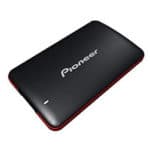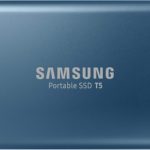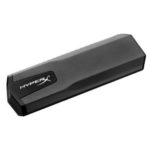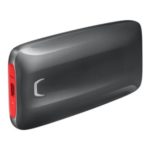Best Portable SSD For 2022
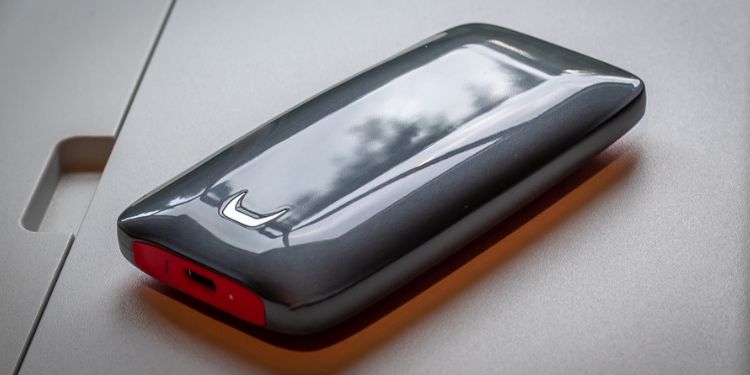
With the introduction of the USB 3.1 Gen 2 standard, the day of the USB SSD has arrived. SSDs have slowly but steadily taken over the desktop PC space, with HDD shipments plummeting as SSDs get faster and more affordable. This process is only going to continue in the desktop space, and it’s becoming prevalent for external drives, too.
It’s time to join the portable SSD revolution, but which drive is best for you?
Products at a Glance
Best Portable SSD For 2022
- Lowest price
- Decent speed
- Low capacity
This is the option for budget users. If you want SSD-grade speeds without breaking the bank, the Pioneer 3D NAND External SSD is the pick of choice. This should work great as supplemental storage to any gaming console or PC… but its 3.1 Gen 1 interface will result in slower speeds compared to other drives on this list.
For what you’re paying, we think this is a genuinely great value. We especially recommend it for students or IT workers, who don’t need massive storage size but do benefit from faster read and write speeds. It’s just under $50– what more can you ask for?

Best Portable SSD For 2022
- Built like a tank
- Great speed
- Fairly small
- Expensive
If you’re worried about dropping your external SSD, then this ADATA SSD should be right for you. While SSDs, in general, are far more tolerant of drops and shock than HDDs (since they have no moving parts), having a shockproof chassis can still give you more peace of mind. Not just shockproof, either– this drive is also IP68 waterproof and dustproof, which gives it a good bit more durability than the other drives on this list.
Also, it’s pretty small.
While these features do come at a slight price to speed in the price range, this is still a stellar option. You can even opt for the 256 or 512 GB models if you want to save some money.
- Ideal balance of speed and storage
- Great value for its price range
- Small size
- Expensive
The Samsung T5 Portable SSD is our value pick. Not only does it have great price-per-gigabyte, but it also boasts the best speeds possible with a USB 3.1 Gen 2 connection; roughly 540 MB/s. This is on par with desktop SATA SSDs, and at a price that rivals SATA SSDs of the same capacity. Add that to the increased portability and you have a great SSD, period, not just a good external SSD.
The only real downside of this one is that it’s expensive. It may be a good value in terms of what you’re getting for the money, but that doesn’t make it cheap. The cheaper 500 GB Model can alleviate this, but isn’t quite as strong in terms of price-per-gigabyte.
- Incredibly small, comparable to a USB flash drive
- Great speeds despite smaller size
- A bit more expensive than competing options at the same price, especially per-gig
The HyperX Savage EXO is our pick for best portable SSD drive– emphasis on portable. In size, this drive is very comparable to a USB flash drive, but with far faster speeds (up to 500 MB/s). This is SATA SSD-tier speeds, though just a few notches below what top SATA/USB 3.1 Gen 2 SSDs are capable of.
The 480 GB capacity is decent, but the pricing is a bit worse than competing 400-500 GB portable SSDs in this price range. If your main goal is an SSD that can easily fit in your pocket, a slight price premium for this HyperX Savage EXO shouldn’t bother you too much. Its higher-end 960 GB model is also an improvement in terms of price-per-gigabyte.
- The fastest external SSD, bar none
- Fairly compact
- Shock-resistant frame
- Incredibly expensive
Last but certainly not least is the Samsung X5 Portable Thunderbolt 3 SSD. Unlike the other SSDs on this list, this one uses the Thunderbolt 3 standard, which is far faster than any currently-existing variation of USB. It’s so fast, in fact, that this external SSD is capable of 2.8 GB/s reads and 2.3 GB/s writes– that’s in the tier of an NVMe desktop SSD. We think that’s pretty impressive for a portable storage drive.
However, there’s a catch…
The price. The price for this SSD is monstrously high, despite offering only 500 GB in storage space. Outside of a very specific segment of users, this price-per-gigabyte will be unacceptable. It also offers 1TB and 2TB drives, but these only serve to exacerbate the poor price-per-gigabyte problem, not improve it in any way.
If speed is all you need, the Samsung X5 is a viable option. It’s blazing-fast, stylish, and built with a shock-resistant frame. All of that goodness comes at a price, though- and a very significant one, at that.
Buying The Best Portable SSD For You
In case you’re having trouble picking out the right portable SSD, we’ve included a buying guide for your convenience. Fortunately, there isn’t a lot of technical jargon that needs to be broken down for these products– just a few key points that should be known before buying.
Let’s get into it.
USB and Thunderbolt Interfaces
The interface of your SSD will determine the maximum possible speed of the drive inside.
In the desktop space, SATA 3 has limited SATA SSDs to a speed of roughly ~500 MB/s read, with similar write speeds. Using PCI Express and NVMe standards, M.2 SSDs are able to achieve speeds as high as 3.5 GB/s.
USB generations prior to 3.1 Gen 2 weren’t enough to keep up with SATA SSD standards, and Thunderbolt-powered SSDs have been uncommon until very recently. With USB 3.1 Gen 2 and Thunderbolt 3 standards, what is possible from portable SSDs?
If you’re confused by the USB generation’s new naming format, don’t worry. You’re not the only one. Check out this video to better understand what they’ve done.
USB 3.1 Gen 2
With a compatible USB 3.1 Gen 2 connection, portable SSDs can now match SATA SSD speeds. The best you’ll get is roughly in the range of 550 MB/s read, which is in line with what you see on desktops. Many of our selections are slightly slower than this, but still far faster than any HDD or standard USB flash drive.
Thunderbolt 3
The Thunderbolt 3 connection is truly stellar, currently offering peak SSD performance at 2.8 GB/s. This is done through a combination of the Thunderbolt 3 technology and NVMe SSD technology used by laptops and desktop PCs. While this doesn’t quite reach the peak of what’s possible with desktop NVMe setups, it comes close… and significantly exceeds any currently-existing USB SSD.
Storage size, and what you need
Here are a few common sizes, and their ideal use scenarios. If you want to make an external drive last, buy the best you can afford.
- 400 GB or less – Ideal for music, project files, and other vital documents. Won’t store that many games or movies.
- 500 GB – Ideal for a few games/movies, as well as music and vital documents.
- 1 TB – Great for games and movies, within moderation. Music and vital docs are taken care of, too.
- 2 TB – Superb for games and movies, little moderation required. Will come at a price premium, though.
Our Verdict


